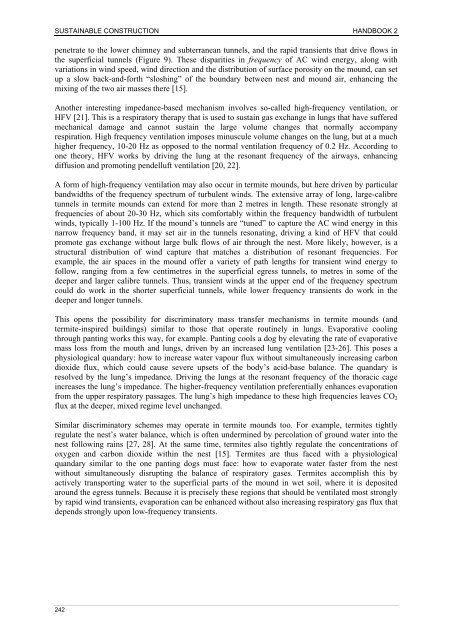Industrialised, Integrated, Intelligent sustainable Construction - I3con
Industrialised, Integrated, Intelligent sustainable Construction - I3con
Industrialised, Integrated, Intelligent sustainable Construction - I3con
You also want an ePaper? Increase the reach of your titles
YUMPU automatically turns print PDFs into web optimized ePapers that Google loves.
SUSTAINABLE CONSTRUCTION HANDBOOK 2<br />
penetrate to the lower chimney and subterranean tunnels, and the rapid transients that drive flows in<br />
the superficial tunnels (Figure 9). These disparities in frequency of AC wind energy, along with<br />
variations in wind speed, wind direction and the distribution of surface porosity on the mound, can set<br />
up a slow back-and-forth “sloshing” of the boundary between nest and mound air, enhancing the<br />
mixing of the two air masses there [15].<br />
Another interesting impedance-based mechanism involves so-called high-frequency ventilation, or<br />
HFV [21]. This is a respiratory therapy that is used to sustain gas exchange in lungs that have suffered<br />
mechanical damage and cannot sustain the large volume changes that normally accompany<br />
respiration. High frequency ventilation imposes minuscule volume changes on the lung, but at a much<br />
higher frequency, 10-20 Hz as opposed to the normal ventilation frequency of 0.2 Hz. According to<br />
one theory, HFV works by driving the lung at the resonant frequency of the airways, enhancing<br />
diffusion and promoting pendelluft ventilation [20, 22].<br />
A form of high-frequency ventilation may also occur in termite mounds, but here driven by particular<br />
bandwidths of the frequency spectrum of turbulent winds. The extensive array of long, large-calibre<br />
tunnels in termite mounds can extend for more than 2 metres in length. These resonate strongly at<br />
frequencies of about 20-30 Hz, which sits comfortably within the frequency bandwidth of turbulent<br />
winds, typically 1-100 Hz. If the mound’s tunnels are “tuned” to capture the AC wind energy in this<br />
narrow frequency band, it may set air in the tunnels resonating, driving a kind of HFV that could<br />
promote gas exchange without large bulk flows of air through the nest. More likely, however, is a<br />
structural distribution of wind capture that matches a distribution of resonant frequencies. For<br />
example, the air spaces in the mound offer a variety of path lengths for transient wind energy to<br />
follow, ranging from a few centimetres in the superficial egress tunnels, to metres in some of the<br />
deeper and larger calibre tunnels. Thus, transient winds at the upper end of the frequency spectrum<br />
could do work in the shorter superficial tunnels, while lower frequency transients do work in the<br />
deeper and longer tunnels.<br />
This opens the possibility for discriminatory mass transfer mechanisms in termite mounds (and<br />
termite-inspired buildings) similar to those that operate routinely in lungs. Evaporative cooling<br />
through panting works this way, for example. Panting cools a dog by elevating the rate of evaporative<br />
mass loss from the mouth and lungs, driven by an increased lung ventilation [23-26]. This poses a<br />
physiological quandary: how to increase water vapour flux without simultaneously increasing carbon<br />
dioxide flux, which could cause severe upsets of the body’s acid-base balance. The quandary is<br />
resolved by the lung’s impedance. Driving the lungs at the resonant frequency of the thoracic cage<br />
increases the lung’s impedance. The higher-frequency ventilation preferentially enhances evaporation<br />
from the upper respiratory passages. The lung’s high impedance to these high frequencies leaves CO2<br />
flux at the deeper, mixed regime level unchanged.<br />
Similar discriminatory schemes may operate in termite mounds too. For example, termites tightly<br />
regulate the nest’s water balance, which is often undermined by percolation of ground water into the<br />
nest following rains [27, 28]. At the same time, termites also tightly regulate the concentrations of<br />
oxygen and carbon dioxide within the nest [15]. Termites are thus faced with a physiological<br />
quandary similar to the one panting dogs must face: how to evaporate water faster from the nest<br />
without simultaneously disrupting the balance of respiratory gases. Termites accomplish this by<br />
actively transporting water to the superficial parts of the mound in wet soil, where it is deposited<br />
around the egress tunnels. Because it is precisely these regions that should be ventilated most strongly<br />
by rapid wind transients, evaporation can be enhanced without also increasing respiratory gas flux that<br />
depends strongly upon low-frequency transients.<br />
242






